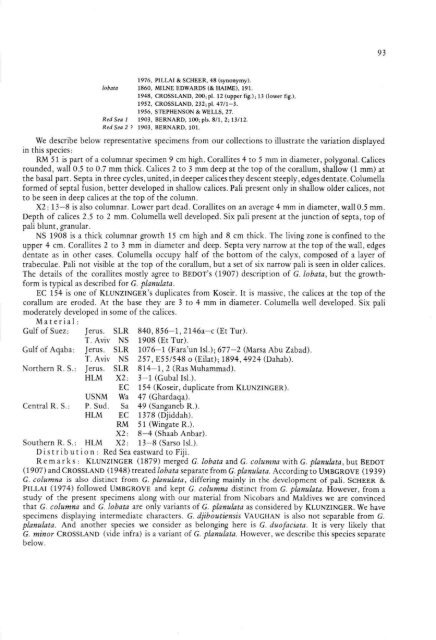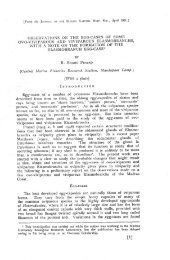PDF - Eprints@CMFRI
PDF - Eprints@CMFRI
PDF - Eprints@CMFRI
You also want an ePaper? Increase the reach of your titles
YUMPU automatically turns print PDFs into web optimized ePapers that Google loves.
93<br />
1976, PI LLAI & SCHEER, 48 (synonymy).<br />
lobata 1860, MILNE EDWARDS ( & HAIME ), 19l.<br />
1948, CROSSLAND, 200; pI. 12 (upp" fig.); 13 (low" fig.).<br />
1952, CROSSLAND, 232 ; pI. 47/ 1- 3.<br />
1956, STEPHENSON & WELLS, 27.<br />
Red Sea 1 1903, BERNARD. 100; pI s. 8/ 1, 2; 13/ 12.<br />
Red Sea 2? 1903, BERNARD, 101.<br />
We describe below representative specimens from our collections to illustrate t he variation displayed<br />
in this species:<br />
RM 51 is part of a columnar specimen 9 cm high. Corallites 4 to 5 mm in diameter, polygona!. Calices<br />
rounded, wall 0.5 to 0.7 mm thick. Calices 2 to 3 mm deep at the top of the corallum, shallow (1 mm) at<br />
t he basal part. Septa in three cycles, united, in deeper calices they descent steeply, edges dentate. Columella<br />
formed of septal fusion, better developed in shallow calices. Pali present only in sha llow older calices, not<br />
to be seen in deep calices at the top of the column.<br />
X2 : 13-8 is also columnar. Lower part dead. Corallites on an average 4 mm in diameter, wall 0.5 mm.<br />
Depth of calices 2.5 to 2 mm . Columella well developed. Six pali present at the junction of septa, top of<br />
pali blunt, granular.<br />
NS 1908 is a thick columnar growth 15 cm high and 8 cm thick . The living zone is confined to the<br />
upper 4 cm. Corallites 2 to 3 mm in diameter and deep. Septa very narrow at the top of the wall , edges<br />
dentate as in other cases. Columella occupy half of the bottom of the calyx, composed of a layer of<br />
trabeculae. Pali not visible at the top of the corallum, but a set of six narrOW pali is seen in older calices.<br />
The details of the corallites mostly agree to BEDOT'S (1907) description of C. lobata, but the growthform<br />
is typical as described for C. planulata .<br />
EC 154 is one of KLUNZING ER's duplicates from Koseir. It is massive, t he calices at the top of the<br />
corallum are eroded. At the base they are 3 to 4 mm in diameter. Columella well developed . Six pali<br />
moderately developed in some of the calices.<br />
Mat e ri a l :<br />
Gul f of Suez: ] erus. SLR 840,856- 1, 2146a-c (Et Tur).<br />
T. Aviv NS 1908 (Et Tur).<br />
Gulf of Aqaba: ] erus. SLR 1076- 1 (Fara'un Is!.); 677- 2 (Marsa Abu Zabad).<br />
T. Aviv NS 257 , E55 /548 0 (Eilat) ; 1894, 4924 (Dahab).<br />
Northern R. S.: ] erus. SLR 8 14- 1,2 (Ras Muhammad).<br />
HLM X2: 3- 1 (Gubal ls!.).<br />
EC 154 (Koseir, duplicate from KL UNZINGE R).<br />
USNM Wa 47 (Ghardaqa).<br />
Central R. S.: P. Sud. Sa 49 (Sanganeb R.).<br />
HLM EC 13 78 (Djiddah).<br />
RM 51 (Wingate R.).<br />
X2 : 8-4 (Shaab Anbar).<br />
Southern R. S.: HLM X2 : 13- 8 (Sarso Is!,).<br />
Di s t rib uti 0 n : Red Sea eastward to Fiji.<br />
R em ark s: KLU NZINGER (1879) merged C. Lobata and C. coLumna with C. plt/nulata , but BEDOT<br />
(1907) and CROSSLAND (1948) treated lobata separate from C. planulata. According to UMBGROVE (1939)<br />
G. columna is also distinct from G. planulata, differing mainly in t he development of pali. SCHEER &<br />
PILLAI (1974) followed UMBGROVE and kept C. columna distinct from C. planulata. However, from a<br />
study of the present specimens along with our material from icobars and Maldives we are convinced<br />
t hat C. columna and C. lobata are only variants of C. planulata as considered by KLUNZING ER. We have<br />
specimens displaying intermediate characters. G. djibout;ensis VAUGHAN is also not separable from C.<br />
planulata. And another species we consider as belonging here is C. duofac;ata. It is very likely that<br />
C. minor CROSSLA, D (vide infra) is a variant of C. planulata. However, we describe this species separate<br />
below.
















